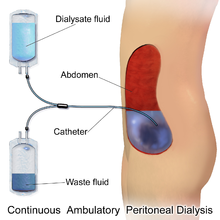Epidemiology and treatment outcome of peritoneal dialysis-related peritonitis in end stage kidney disease patients with continuous ambulatory peritoneal dialysis: a retrospective cohort study in Saraburi Hospital
Keywords:
End stage kidney disease patients with continuous ambulatory peritoneal dialysis, peritoneal dialysis related peritonitis, epidemiology, risk factor for peritoneal dialysis related peritonitisAbstract
Introduction: Peritoneal dialysis-related peritonitis is a common complication in end-stage renal disease patients who undergo continuous ambulatory peritoneal dialysis (CAPD). This study analyzed the epidemiology of peritoneal dialysis-related peritonitis, risk factors, treatment outcomes and factors that may have contributed to catheter removal.
Methodology: A total of 582 events of peritoneal dialysis-related peritonitis among end-stage renal disease patients who received treatment at Saraburi hospital from January 1st 2011 to December 31st 2020 were included into the study. Patients’ data was retrospectively collected from medical records and analyzed using Cox proportional hazard analyses to identify risk factors for catheter removal and treatment outcomes.
Results: Patients who developed peritoneal dialysis-related peritonitis had an average age of 56 years and the average duration of peritoneal dialysis prior to peritonitis was 588 days. Of the 582 events, 312 (53.6%) had diabetes mellitus. Cloudy peritoneal dialysis fluid was the most common clinical presentation (64.7%). The majority of pathogens were gram-negative bacteria [223 events (38.3%)] with Escherichia coli being the most common pathogen 32.3%. Gram-positive bacteria [206 events (35.3%)] were the second most common with Staphylococcus coagulase negative being the most common pathogen (35.4%). No organism was isolated in 141 events (24.2%) and fungal peritonitis was found in 13 patients (2.2%). Removal of catheter occurred in 164 events (28.2%) and 23 patients died (3.9%). Multivariable analysis showed that serum albumin levels (HR 0.51, p-value < 0.01) and fungal peritonitis (HR 2.68, p-value < 0.01) were associated with catheter removal.
Conclusion: The epidemiology of peritoneal dialysis-related peritonitis from this study showed that gram-negative bacteria was the majority of pathogens in the past decade. Fungal infection had contributed to removal of catheter among CAPD patients. Good serum albumin level might have lessened the risk of catheter removal.
References
Tantivess S, Werayingyong P, Chuengsaman P, Teerawattananon Y. Universal coverage of renal dialysis in Thailand: Promise, progress, and prospects. BMJ 2013;346(1):1–6.
Akoh JA. Peritoneal dialysis associated infections: An update on diagnosis and management. World J Nephrol 2012; 1(4): 106.
De Vriese AS, Mortier S, Lameire NH. What happens to the peritoneal membrane in long-term peritoneal dialysis? Perit Dial Int 2001;21(SUPPL.3):12–5.
Davies SJ, Bryan J, Phillips L, Russell GI. Longitudinal changes in peritoneal kinetics: the effects of peritoneal dialysis and peritonitis. Nephrol Dial Transpl 1996;11(3):498–506.
Brown EA, Van Biesen W, Finkelstein FO, Hurst H, Johnson DW, Kawanishi H, et al. Length of time on peritoneal dialysis and encapsulating peritoneal sclerosis: position paper for ISPD. Perit Dial Int 2009;29(6):595–600.
Li PK, Szeto CC, Piraino B, Arteaga J De, Fan S, Figueiredo AE, et al. ISPD Guidelines/Recommendations ISPD Peritonitis Recommendations: 2016 Update on Prevention and Treatment. Perit Dial Int 2016;36(5):481-508.
Piyarat Rojsanga, Prognostic factors of refractory peritonitis in peritoneal dialysis patients. Udonthani hospitaal medical journal Vol.28 No.1 (January-April), 2020.
Tian Y, Xie X, Xiang S, Yang X, Zhang X, Shou Z, Chen J. Risk factors and outcomes of high peritonitis rate in continuous ambulatory peritoneal dialysis patients: A retrospective study. Medicine. 2016 Dec;95(49).
Chen HL, Tarng DC, Huang LH. Risk factors associated with outcomes of peritoneal dialysis in Taiwan: An analysis using a competing risk model. Medicine. 2019 Feb;98(6).
Prasad N, Gupta A, Sharma RK, Sinha A, Kumar R. Impact of nutritional status on peritonitis in CAPD patients. Peritoneal Dialysis International. 20007 Jan 1;27(1):42-7.
Krittapong Somboon, and Siriporn Kamsa-ard, Epidermiology and Treatment Outcome of Peritoneal Dialysis (PD)-Related Peritonitis. Mahasarakham hospital journal Vol.16 No.1 (January-April), 2019.

Downloads
Published
How to Cite
Issue
Section
License
Copyright (c) 2023 Phakatip Suansuk, Voralak Vichapat, Suthasini Theanwan

This work is licensed under a Creative Commons Attribution-NonCommercial-NoDerivatives 4.0 International License.
Journal of TCI is licensed under a Creative Commons Attribution-NonCommercial-NoDerivatives 4.0 International (CC BY-NC-ND 4.0) licence, unless otherwise stated. Please read our Policies page for more information.





